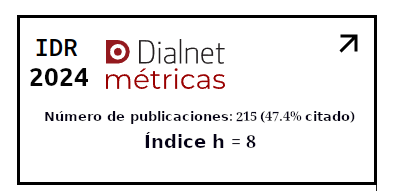Savings behaviors scale for adults in Buenos Aires, Argentina
DOI:
https://doi.org/10.30545/academo.2025.n2.1084Keywords:
Savings, financial behaviors, psychometrics, economic psychologyAbstract
The process of constructing a scale to measure savings behaviors is presented, given that these are crucial to achieve stability and the fulfillment of goals, especially in unstable economies such as the Argentinean one. After drafting 16 items, these were subjected to expert judgment and administered to a non-probabilistic sample of 384 participants from the general population of the Buenos Aires Metropolitan Area (57.6% women, mean age = 37.94 and SD = 14.98). A preliminary purification and an exploratory factor analysis based on the polychoric correlation matrix was then performed, implementing the unweighted least squares method for the extraction. The final version consists of 10 items with an ordinal Alpha and Omega of .86 and a single factor describing 45% of the variance. Its total score was associated with measures of Financial Anxiety, the Big Five Conscientiousness domain, Impulsive Buying and Money Management. Differential patterns were identified according to gender, social class and educational level. It is concluded that the Savings Scale has adequate evidence of validity and reliability, allowing to address the particularities of the local environment with great potential for clinical, institutional and financial use.
Downloads
References
Archuleta, K. L., Dale, A., & Spann, S. M. (2013). College students and financial distress: exploring debt, financial satisfaction, and financial anxiety. Journal of Financial Counseling and Planning, 24(2), 50-62. https://files.eric.ed.gov.pdf
Asebedo, S. D. (2018). Personality and financial behavior. En C. R. Chaffin (Ed.), Client Psychology (pp. 137-153). CFP Board. https://doi.org/10.1002/9781119440895.ch9
Asebedo, S. D., Wilmarth, M. J., Seay, M. C., Archuleta, K., Brase, G. L., & MacDonald, M. (2018). Personality and Saving Behavior Among Older Adults. Journal of Consumer Affairs (53)2, 488-519. https://doi.org/10.1111/joca.12199
Atkinson, A., & Messy, F.A. (2012). Measuring financial literacy: Results of the OECD/International Network on Financial Education (INFE) pilot study. OECD Working Papers on Finance, Insurance and Private Pensions, (15). https://doi.org/10.1111/j.1745-6606.2010.01170.x
Auné, S. E., Abal, F. J. P., & Attorresi, H. F. (2016). Diseño y construcción de una escala de conducta prosocial para adultos. Revista Iberoamericana de Diagnóstico y Evaluación Psicológica, 2(42), 15-25. http://hdl.handle.net/11336/47068
Baidoo, S. T., Boateng, E., & Amponsah, M. (2018). Understanding the Determinants of Saving in Ghana: Does Financial Literacy Matter? Journal of International Development, 30(5), 886–903.https://doi.org/10.1002/jid.3377
Bandura, A. (1971). Social learning theory. Prentice Hall: Englewood cliffs.https://www.
Bandura_SocialLearningTheory.pdf
Carstens, A. (05 de April de 2022). The return of inflation. International Center for Monetary and Banking Studies, Geneva. https://www.bis.org/speeches.pdf
Copur, Z., & Gutter, M.S. (2019). Economic, Sociological, and Psychological Factors of the Saving Behavior: Turkey Case. Journal of Family and Economic Issues, 40(2), 305–322. https://doi.org/10.1007/s10834-018-09606-y
Coremberg, A. A., Goldszier, P., Heymann, D., & Ramos, A. (2007). Patrones de la Inversión y el Ahorro en la Argentina. Santiago de Chile: CEPAL. https://hdl.handle.net/11362/5434
Costa, P. T., Jr., & McCrae, R. R. (2008). Inventario de Personalidad NEO Revisado (NEO PI-R). Inventario NEO reducido de Cinco Factores (NEO-FFI). Manual. 3ª edición. Madrid: TEA.
D’Avella, N. J. (2012). Pesos, dólares y ladrillos: la espacialidad del ahorro en la Argentina. Boletín de Antropología Universidad de Antioquia, 27(44), 127-143.https://www.reda
lyc.org/pdf/557/55726909007.pdf
Dew, J., & Xiao, J.J. (2011). The financial management behavior scale: Development and validation. Journal of Financial Counseling and Planning, 22(1), 43-59. https://www.afcpe.org/journalarticles/volume=387yarticle=403
Donnelly, G., Iyer, R., & Howell, R. T. (2012). The Big Five personality traits, materialistic values and financial well-being of self-reported money managers. Journal of Economic Psychology, 33(1), 1129–1142. https://doi.org/10.1016/
j.joep.2012.08.001
Farrell, L., Fry, T. R. L., & Risse, L. (2016). The significance of financial self-efficacy in explaining women's personal finance behaviour. Journal of Economic Psychology 54, 85–99. https://doi.org/10.1016/
j.joep.2015.07.001
Feige, E. L. (2012). New estimates of US currency abroad, the domestic money supply and the unreported economy. Crime, Law and Social Change, 57(3), 239-263. https://doi.org/10.1007/s10611-011-9348-8
Ferrando, P. J., & Lorenzo-Seva, U. (2022). Gulliksen's pool: A quick tool for preliminary detection of inappropriate items. Technical report. Universitat Rovirai Virgili.
Fisher, P. (2010). Gender differences in personal saving behaviors. Journal of Financial Counseling and Planning, 21(1). https://ssrn.com/abstract=2803965
Gaggero, A., Gaggero, J., & Rúa, M. (2015). Principales características e impacto macroeconómico de la fuga de capitales en Argentina. Problemas del desarrollo, 46(182), 67-90. https://doi.org/10.1016/j.rpd.201
06.002
Gambetti, E., & Giusberti, F. (2012). The effect of anger and anxiety traits on investment decisions. Journal of Economic Psychology, 33(6), 1059–1069. https://doi.org/10.1016/
j.joep.2012.07.001
Goyal, K., Kumar, S., & Xiao, J. J. (2021). Antecedents and consequences of Personal Financial Management Behavior: a systematic literature review and future research agenda. International Journal of Bank Marketing, 39(7), 1166-1207. https://doi.org/10.1108/IJBM-12-2020-0612
Grable, J. E., Archuleta, K. L., Ford, M. R., Kruger, M., Gale, J., & Goetz, J. (2019). The Moderating Effect of Generalized Anxiety and Financial Knowledge on Financial Management Behavior. Contemporary Family Therapy 42, 15–24. https://doi.org/10.1007/s10591-019-09520-x
Gudmunson, C., Ray, S. K., & Xiao, J. J. (2016). Financial socialization. En J. J. Xiao (Ed.), Handbook of Consumer Finance Research (pp. 61-72). Cham: Springer. https://doi.org/10.1007/978-3-319-28887-1_5
Hilgert, M.A., Hogarth, J. M., & Beverly, S. G. (2003). Household financial management: The connection between knowledge and behavior. Federal Reserve Bulletin 89, 309-322.
Instituto Nacional de Estadísticas y Censos. (2024). Índice de precios al consumidor (IPC): febrero de 2024. Informes técnicos, 8(54). https:
//www.indec.gob.ar/uploads/informes.pdf
Jares, A. G. (2023). Construcción de una escala para la medición de conductas financieras de manejo del dinero. [Tesis de Licenciatura, Universidad de Buenos Aires] Tesis Publicadas. http://academica.psi.uba.ar/
Psi/DescargarTesis
Jorgensen, B. L. (2007). Financial literacy of college students: Parental and peer influences. [Tesis doctoral, The Virginia Polytechnic Institute and State University]. https://n9.cl/jorgensenthesis
Kahneman, D., & Tversky, A. (1979). Prospect theory: An analysis of decision under risk. Econometrica, 47, 263–292. https://encr.pw/3mqD7
Kim, J., Garman, E. T., & Sorhaindo, B. (2003). Relationship among credit counseling clients’ financial wellbeing, financial behaviors, financial stressor events, and health”, Financial Counseling and Planning 14, 75-87. https://deliverypdf.ssrn.com/delivery.php=pdf&INDEX
Kimball, M. S. (1990). Precautionary Saving in the Small and in the Large. Econometrica, 58(1), 53-73. https://doi.org/10.2307/2938334
Ksendzova, M., Donnelly, G. E., y Howell, R. T. (2017). A brief money management scale and its associations with personality, financial health, and hypothetical debt repayment. Journal of Financial Counseling and Planning, 28(1), 62-75. https://doi.org/10.1891/1052-3073.28.1.62
Martins, A., & Rodríguez, L. (2021). Conducta financiera del venezolano: Una escala para contextos de adversidad económica. Revista Evaluar, 21(1), 1-16. https://doi.org/
35670/1667-4545.v21.n1.32829
Mikulic, I. M., Caballero, R., & Crespi, M. (2022). Calidad De Vida y Necesidades Insatisfechas en Población General de Argentina en Situación de Pandemia Covid-19. Revista Argentina de Ciencias del Comportamiento (RACC), 14(1), 168-169.
Modigliani, F., & Brumberg, R. (1954). Utility analysis and the consumption function: An interpretation of cross-section data. En K., Kurihara (Ed.), Post Keynesian Economics Franco Modigliani (pp. 388-436). Rutgers University Press. https://encr.pw/uuLLt
Morgan, P. J., & Long, T. Q. (2020). Financial Literacy, Financial Inclusion, and Savings Behavior in Laos. Journal of Asian Economics 68. https://doi.org/10.1016/j.asieco.2020.101197
O’Neill, B., & Xiao, J. J. (2012). Financial behaviors before and after the financial crisis: Evidence from an online survey. Financial Counseling and Planning, 23(1), 33–46.
Perry, V. G., & Morris, M. D. (2005). Who Is in Control? The Role of Self-Perception, Knowledge, and Income in Explaining Consumer Financial Behavior. Journal of Consumer Affairs, 39(2), 299–313.
Porter, N. M., & Garman, E. T. (1993). Testing a conceptual model of financial well-being. Financial Counselling and Planning, 4, 135–164.
Prihartono, M. R. D., & Asandimitra, N. (2018). Analysis factors influencing financial management behaviour. International Journal of Academic Research in Business and Social Sciences, 8(8), 308-326. http://dx.doi.org/
6007/IJARBSS/v8-i8/4471
Prochaska-Cue, K. (1993). An exploratory study for a model of personal financial management style. Journal of Financial Counseling and Planning, 4, 111-134.
Revilla, R. G., Acosta, C., & Reyna, C. (2013). Estudios de validez y confiabilidad de la escala de compra impulsiva en jóvenes y adultos de la ciudad de Córdoba, Argentina. Ciencias psicológicas, 7(2), 133-142.
Rook, D. W., & Fisher, R. J. (1995). Normative influences on impulsive buying. Journal of Consumer Research, 22, 305-313. https://doi.org/10.1086/209452
Sánchez González, J. K., Jares, A. G, García Díaz, A. M., & Abal, F. J. P. (2023). Responsabilidad del Modelo de los Cinco Grandes: medición basada en aspectos proactivos e inhibitorios de la conducta. Memorias XV Congreso Internacional de Investigación y Práctica Profesional en Psicología, 47-50.http://jimemorias.psi.uba.ar/
Sekścińska, K., Trzcińska, A., Pankowski, D., Pisula, E., & Wytrychiewicz-Pankowska, K. (2022). Financial factors and psychological distress during the COVID-19 pandemic in Poland. International Journal of Environmental Research and Public Health, 19(3), 1798. https://doi.org/10.3390/ijerph19031798
Shefrin, H. M., & Thaler, R. H. (1988). The behavioral life-cycle hypothesis. Economic Inquiry, 26(4), 609–643. https://doi.org/10.1111/j.1465-7295.1988.tb01520.x
Škreblin Kirbiš, I., Vehovec, M., & Galić, Z. (2017). Relationship between financial satisfaction and financial literacy: Exploring gender differences. Društvena istraživanja: časopis za opća društvena pitanja, 26(2), 165-185. https://doi.org/10.5559/di.26.2.02
Thaler, R. H. (2015). La psicología económica. Bilbao, España: Ediciones Deusto.
Universidad Católica Argentina (2023). Privaciones sociales y desigualdades estructurales: condiciones materiales de los hogares en un escenario de estancamiento económico (2010-2022). Documento estadístico del Barómetro de la Deuda Social Argentina. https://repositorio.uca.edu.ar/handle/123456789/16510
Veiga, R. T., Avelar, C., Moura, L. R. C., & Higuchi, A. K. (2019). Validation of scales to research the personal financial management. Revista Brasileira de Gestao de Negocios, 21, 332-348. https://doi.org/10.7819/rbgn.v21i2.3976
Walczak, D., & Pieńkowska-Kamieniecka, S. (2018). Gender diferences in financial behaviours. Engineering Economics, 29(1), 123–132. https://doi.org/10.5755/j01.ee.29.1.16400
Xiao, J. J. (2008). Appliying behavior theories to financial behavior. En J. J. Xiao (Ed.), Handbook of Consumer Finance Research, 69-81. https://doi.org/10.1007/978-0-387-75734-6_5
Xiao, J. J., Ford, M. W., & Kim, J. (2011). Consumer financial behavior: An interdisciplinary review of selected theories and research. Family and Consumer Sciences Research Journal, 39(4), 399-414. https://doi.org/10.1111/j.1552-3934.2011.02078.x









